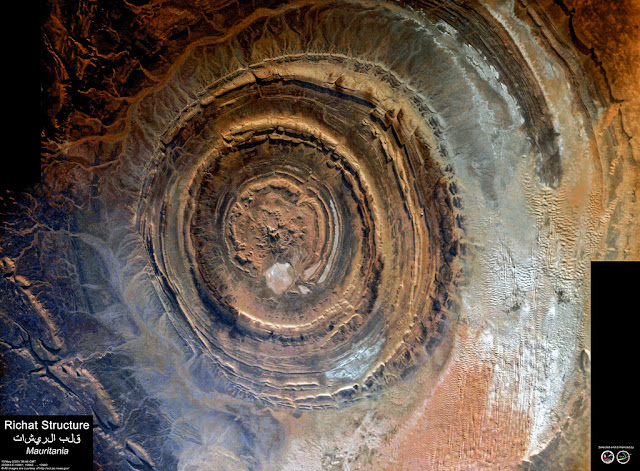WHAT IS "THE EYE OF
AFRICA"?
Visible only from the
sky or from space, the structure of Richat - called “the eye of Africa”, some
says “the eye of Sahara” also - is a huge geological structure located in the
Mauritanian desert.
if you ever fly over the Sahara Desert in Mauritania, you will
certainly see an astonishing structure standing out from the landscape, like a
huge eye pointed towards the sky, "the eye of Africa". Better known
as the Richat structure or dome of Richat, this formation is located near the
city of Ouadane and is visible from the air, and even from space. No wonder
when you know that it is 50 kilometers wide.
[This picture is collected from Flickr By Stuart Rankin which is licensed under CC BY-NC 2.0]
Discovered for a long time, the structure of Richat was visited in
the 1950s by scientists before being revealed on a large scale by one of the
American Gemini space missions. At the time, astronauts were thus amazed at the
atypical characteristics of the structure. Superimposed circles of several tens
of kilometers in diameter forming a kind of giant ammonite.
Huge crater in the heart
of Mauritania, visible by satellite, this sublime "eye of Africa"
actually results from the erosion of a very old volcano.
A true work of natural art located in the Mauritanian Sahara, the
structure of Richat (from the word "feathers" in Mauritanian Arabic)
has long remained a mystery for geologists. But they now agree to think that it
would be a giant crater testifying to a volcano disappeared for a very long
time.
Called "the eye of Africa", this dome 50 kilometers in
diameter was first spotted in the 1960s by an American space mission. Given its
size, this circular shape can indeed only be observed in full from space!
A VERY DISTANT VOLCANIC ORIGIN
It was initially
believed that it was the result of a large meteorite impact. But the discovery
of magmatic rocks found along the three concentric ledges has delivered another
explanation: "the eye of Africa" in fact hides the eroded remains
of a gigantic volcano active in the Cretaceous, there are 100 million. years.
While it has attracted widespread attention, Richat's structure
has long intrigued researchers who questioned its origin. According to the
earliest interpretations and scientific hypotheses, it was a meteorite impact
that was the origin of the circular structure. Then by further studying the
structure, the specialists discarded this hypothesis to give birth to another.
It was no longer a meteorite impact, but a symmetrical uplift of
the circular anticline type, that is to say an episode of geological folding.
The famous scientist Theodore Monod studied this phenomenon with other friends
and published in 1973 hypotheses which came close to the latest explanations
accepted today.
Since the 2000s, scientists have established that the "Eye of
Africa" actually originated from an extremely rare form of giant
volcanism, dating back to the Cretaceous period, 100 million years ago. The
volcanic phenomenon would have created the dome following rising magma
accompanied by a large amount of hot water. The water then seeped through the
fractures in the earth and dissolved the layers of limestone to form a
veritable "piece of Gruyere".
COLLAPSE
Over time, the sediment
was deformed by the thrust and the cavities grew larger and larger. After a
long and slow erosion, the dome completely collapsed and gave way to the
circular structure that we know today. Only the Paleozoic quartzites (-541 to
-252 million years) making up the layers of the structure have better resisted
erosion and form the concentric rings of the Richat dome.
The wide dissemination of images of this phenomenon by the media has created a tourist and scientific influx to this remote place. A basic reception facility has even been created on the site. Other similar structures exist on Earth, but are less spectacular than the "Eye of Africa".





0 Comments